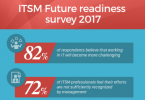What constitutes a perfect customer experience? Imagine a world without having to wait for a customer service representative to answer all your questions. A situation without human mistakes when self-service and artificially intelligent chatbots solve your problems in no time.

Image credit: Unsplash
While it sounds like fiction, we’re closer to this scenario than you might think. Artificial intelligence (AI) has been incorporated across various sectors in recent years.
According to Gartner, organizations will have 35 AI projects in place by 2022, up from only four in 2019. However, it’s not an accessible technology to implement in your business, so you’ll need to turn to professionals. For example, if you own a Magento store, you’ll need to hire specialists providing custom Magento development services to properly integrate a chatbot plugin into your website and modify it.
What AI projects and applications will we see in the future? Let’s look at what we should expect from conversational AI and customer service in 2022 and beyond.
Technologies Behind Conversational AI and Customer Experience Automation
The following technologies are transforming the way humans interact with bots, including:
- natural language processing (NLP);
- automatic speech recognition (ASR);
- advanced dialog management;
- machine learning (ML).
How can all this influence customer experience? Combined with conversational AI, they allow us to converse with robots as we do with each other.
Over the last decade, AI has progressed to the point that we can’t always recognize whether we are talking to a human or a robot. But it’s not just about the “human” level of interactions. AI apps can also make informed decisions based on the actionable insights gathered from data.
According to a survey published by Markets and Markets, the global conversational AI industry is predicted to increase by more than three times in five years. Namely, it will grow from $4.2 billion in 2019 to $15.7 billion by 2024.
Do you still doubt that AI will be the next phase of customer service and a decisive competitive advantage in the coming years? Then, read on to find three conversational AI trends of 2022 and beyond.
3 Ways How Customer Experience Automation and Conversational AI Evolve
1. Going Beyond Predefined Scripts and Rules
Traditional chatbots are like conventional programming techniques. They work on a set of rules, such as “if this, then that, else this”.
Suppose a customer wants to know about the order status. The chatbot goes through its rules, discovers the right scenario, and reacts with a programmed response. It matches terms in the client’s text with keywords in its memory to choose the suitable reply.
For example, the customer specified the “where’s my order” phrase. The relevant response may include the map or line with the place of the order on it. It works for simple questions, but the chatbot doesn’t fully comprehend the dialogue, limiting the customer’s interaction.
Here’s how such chatbots look, using the example of the prAna Facebook chatbot. It allows you to communicate with the help of short phrases to get the most essential information. Unfortunately, you won’t get a human-like experience from this bot.

Screenshot taken on the official prAna Facebook chat
Conversational AI leaves keyword and script restrictions behind. It carries on a full conversation via text or speech, imitating real-life specialists. What’s more, it can translate speech in real-time to sustain a dialogue in the customer’s native language.
What happens when a bot doesn’t understand the input? Traditional chatbots would return the default “Can’t understand the request” answer. And the conversation stops with a customer left frustrated. Case in point, I tried to interact with the Kayak chatbot on Facebook, but the chat appeared to be a dead-end.

Screenshot taken on the official Kayak Facebook chat
Conversational AI can intelligently grasp the context of discussions to request clarification when needed and then explore a large knowledge database for the most relevant responses.
Another crucial factor is how customers feel during the conversation. Powered by associated technologies, conversational AI can determine human emotions with sentiment analysis.
For example, NLP allows chatbots to recognize and solve consumer discontent. It includes examining the choice of words and routing customers to the proper human assistance for fast and effortless processing.
2. Facilitating Hyper-Personalization
Many CRM and customer data platforms (CDP) now leverage conversational AI and ML. For example, here are a couple of AI-powered CRM platforms:
- Salesforce Einstein;
- Zoho;
- C2CRM;
- and others.
Why do they make such a move? It gives them functionalities, such as:
- real-time decisions;
- predictive analysis;
- conversational assistants.
This enables sales teams to better understand and engage buyers.
CDPs have also incorporated AI to unify customer data. Conversational AI gives marketers a better grasp of their customers’ wants, how they feel, and what they’re most likely to do or buy.
What do the AI-enhanced platforms consider? They store the present interaction, purchase and browsing history, past customer service inquiries, and demographics to tailor the next best action for each client. For example, they can predict which products you may find interesting. Explore it in the screenshot of the Ultràchic store below.

Screenshot taken on the official Ultràchic website
Customers crave seamless and hyper-personalized experiences across all channels. That’s why call centers should equip their human agents with intelligent helpers to improve the customer journey.
Below you can see an example of an AI employee at 7-Eleven. The company employed a Korean startup, Deepbrain AI, to create an assistant with the help of real-time video synthesis. It allows for engaging discussions with consumers and realistic lip and tongue sync. It gives faster responses, resulting in a better user experience.

Image credit: Deepbrain AI
What can she tell? She advises consumers on using automatic stores, finding products, restaurants, public transportation, and other topics. She also relies on conversational AI and thousands of pre-recorded lines (such as client names) to make more personalized connections.
3. Creating Connected Customer Journeys
What can spoil the customer experience more than having to repeat yourself? When you speak with a new member of a company’s customer service team, you expect recognition. The same applies to interaction with a company through various channels.
How can an AI customer service system help clients? It can specify initial inquiries and send users to the appropriate person for additional support, thus saving their time, effort, and frustration.
A chatbot or virtual agent records all the data during the customer’s initial contact. As a result, consumers don’t have to explain their problem to a real person once again. It also tracks their journey to enhance current service and support processes and structure.
That’s not all AI is capable of. AI systems may detect when client inquiries go ignored and prioritize them accordingly.
Imagine a customer reaching out to a brand on social media about a problem and never receiving a response. That same consumer calls the company’s customer support line with the same problem later. If the company leverages an AI customer service solution, it will recognize the caller, flag them, and move them to the top of the list. It ensures a perfect omnichannel customer experience.
Why do you need to care about the omnichannel approach at all? According to the Marketing Charts survey, it generates more sales than providing offline-only or online-only experiences.

Image credit: Marketing Charts
Final Word
Regardless of the myths about artificial intelligence, this technology transforms our everyday lives. Many businesses are focused on the time and cost benefits of AI and automation. However, the potential returns for improving customer experience are even more meaningful for both businesses and customers, including:
- AI-driven analytics can quickly interpret the sentiment of customer interactions.
- Conversational AI allows brands to engage with customers worldwide with the help of real-time translation.
- Smart chatbots provide customer and employee insights and stress predictors.
All these capabilities allow businesses to optimize the customer experience. And that’s what we should expect in terms of conversational AI and customer experience automation in 2022 and beyond.





Leave a Comment